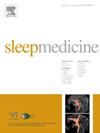Local efficiency analysis of the emotion regulation network in younger and older adults experiencing sleep deprivation: A task-based fMRI study
IF 3.8
2区 医学
Q1 CLINICAL NEUROLOGY
引用次数: 0
Abstract
Previous neuroimaging studies have examined how sleep deprivation affects emotional processing. However, graph theory has not yet been utilized to analyze functional magnetic resonance imaging (fMRI) data in relation to the brain regions and networks involved in emotions and feelings among sleep-deprived individuals. This study involved a dataset comprising 46 younger participants (ages 20–30) and 39 older participants (ages 65–75) who underwent an emotional task-based fMRI investigation. We identified graph edges within the brain's emotional networks and utilized recurrence plots to evaluate local efficiency (LE). In both age groups experiencing sleep deprivation, most brain regions associated with emotion regulation exhibited a decrease in LE across all three types of emotional tasks, with only a few regions showing an increase in LE. Notably, younger adults demonstrated greater LE across most regions following sleep deprivation compared to older adults, particularly in the prefrontal cortex (PFC) components of the emotion regulation network. Conversely, older adults displayed greater LE in certain areas post-sleep deprivation than younger adults, especially in lower-order cortical and some subcortical structures within the emotion regulation network. Our findings indicate that sleep deprivation produces distinct patterns of LE in the emotion regulation network for younger and older adults. This could deepen our understanding of novel mechanisms and potentially inform therapeutic strategies for sleep-related emotional disorders in the future.
经历睡眠剥夺的年轻人和老年人情绪调节网络的局部效率分析:一项基于任务的fMRI研究
之前的神经成像研究已经研究了睡眠剥夺是如何影响情绪处理的。然而,图论尚未被用于分析功能磁共振成像(fMRI)数据,这些数据与睡眠剥夺者的大脑区域和情感网络有关。这项研究涉及的数据集包括46名年轻参与者(20-30岁)和39名年龄较大的参与者(65-75岁),他们接受了基于情绪任务的功能磁共振成像调查。我们确定了大脑情绪网络中的图边,并利用递归图来评估局部效率(LE)。在经历睡眠剥夺的两个年龄组中,大多数与情绪调节相关的大脑区域在所有三种类型的情绪任务中都表现出LE的下降,只有少数区域表现出LE的增加。值得注意的是,与老年人相比,年轻人在睡眠剥夺后的大多数区域表现出更大的LE,尤其是在情绪调节网络的前额叶皮层(PFC)部分。相反,老年人在睡眠剥夺后的某些区域比年轻人表现出更大的LE,特别是在情绪调节网络中的低阶皮层和一些皮层下结构。我们的研究结果表明,睡眠剥夺在年轻人和老年人的情绪调节网络中产生不同的LE模式。这可以加深我们对新机制的理解,并可能为未来睡眠相关情绪障碍的治疗策略提供信息。
本文章由计算机程序翻译,如有差异,请以英文原文为准。
求助全文
约1分钟内获得全文
求助全文
来源期刊

Sleep medicine
医学-临床神经学
CiteScore
8.40
自引率
6.20%
发文量
1060
审稿时长
49 days
期刊介绍:
Sleep Medicine aims to be a journal no one involved in clinical sleep medicine can do without.
A journal primarily focussing on the human aspects of sleep, integrating the various disciplines that are involved in sleep medicine: neurology, clinical neurophysiology, internal medicine (particularly pulmonology and cardiology), psychology, psychiatry, sleep technology, pediatrics, neurosurgery, otorhinolaryngology, and dentistry.
The journal publishes the following types of articles: Reviews (also intended as a way to bridge the gap between basic sleep research and clinical relevance); Original Research Articles; Full-length articles; Brief communications; Controversies; Case reports; Letters to the Editor; Journal search and commentaries; Book reviews; Meeting announcements; Listing of relevant organisations plus web sites.
 求助内容:
求助内容: 应助结果提醒方式:
应助结果提醒方式:


